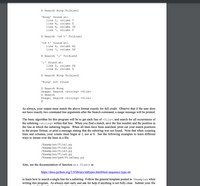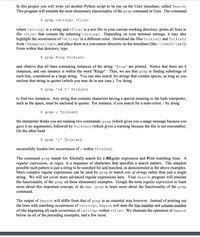
Computer Networking: A Top-Down Approach (7th Edition)
7th Edition
ISBN: 9780133594140
Author: James Kurose, Keith Ross
Publisher: PEARSON
expand_more
expand_more
format_list_bulleted
Question
HOW CAN I DO THIS, I have beenn struggling for nearly 5 hours.
please make sure it prints the line number and column number of every occurance of the search string.

Transcribed Image Text:```
$ Search Ring Tolkien1
'Ring' found at:
line 1, column 7
line 6, column 5
line 6, column 32
line 7, column 5
$ Search 'nd t' Tolkien1
'nd t' found at:
line 6, column 42
line 7, column 50
$ Search ';' Tolkien2
';' found at:
line 2, column 26
line 8, column 5
$ Search Ring Tolkien2
'Ring' not found
$ Search Ring
Usage: Search <string> <file>
$ Search
Usage: Search <string> <file>
```
As always, your output must match the above format exactly for full credit. Observe that if the user does not have exactly two command line arguments after the Search command, a usage message will be printed.
The basic algorithm for this program will be to get each line of `<file>`, and search for all occurrences of the substring `<string>` within that line. When you find a match, save the line number and the position in the line at which the substring begins. When all lines have been searched, print out your match positions in the proper format, or print a message stating that the substring was not found. Note that when counting lines and columns, your counts must begin at 1, not at 0. See the following examples to learn different ways to iterate over the lines in a file.
/Examples/File1.py
/Examples/File2.py
/Examples/File3.py
/Examples/File4.py
/Examples/pa6/FileCopy.py
Also, see the documentation of function `str.find()` at
https://docs.python.org/3.9/library/stdtypes.html#text-sequence-type-str
to learn how to search a single string for a substring. Follow the general template posted in `/Examples` when writing your program. As always start early and ask for help if anything is not fully clear. Submit your file
```

Transcribed Image Text:In this project, you will write yet another Python script to be run on the Unix timeshare, called Search. This program will emulate the most elementary functionality of the grep command in Unix. The command
```
$ grep <string> <file>
```
where `<string>` is a string and `<file>` is a text file in your current working directory, prints all lines in file `<file>` that contain the substring `<string>`. Depending on your terminal settings, it may also highlight the occurrences of `<string>` in a different color. Download the files Tolkien1 and Tolkien2 from /Examples/lab5, and place them in a convenient directory on the timeshare (like ~/cse20/lab5). From within that directory, type
```
$ grep Ring Tolkien1
```
and observe that all lines containing instances of the string 'Ring' are printed. Notice that there are 4 instances, and one instance is within the word "Rings". Thus, we see that grep is finding substrings of each line, considered as a large string. You can also search for strings that contain spaces, as long as you enclose that string in quotes (which you may do in any case.) Try doing
```
$ grep 'nd t' Tolkien1
```
to find two instances. Any string that contains characters having a special meaning to the bash interpreter, such as the space, must be enclosed in quotes. For instance, if you search for a semi-colon ; by doing
```
$ grep ; Tolkien2
```
the interpreter thinks you are running two commands: grep (which gives you a usage message because you gave it no arguments), followed by Tolkien2 (which gives a warning because the file is not executable). On the other hand
```
$ grep ';' Tolkien2
```
successfully locates two occurrences of ; within Tolkien2.
The command grep stands for: Globally search for a REgular expression and Print matching lines. A regular expression, or regex, is a sequence of characters that specifies a search pattern. The simplest possible such pattern is just a string to be searched for and matched, as demonstrated in the above examples. More complex regular expressions can be used by grep to match sets of strings rather than just a single string. We will not cover more advanced regular expressions here. Your Search program will emulate the functionality of the grep on these elementary examples. Google the term regular expression to
Expert Solution
This question has been solved!
Explore an expertly crafted, step-by-step solution for a thorough understanding of key concepts.
This is a popular solution
Trending nowThis is a popular solution!
Step by stepSolved in 2 steps with 1 images

Knowledge Booster
Similar questions
- In the Backtracking algorithm, you are allowed to use Depth-first search. True or falsearrow_forwardWhich of the following can add an entry into the dictionary my_dict? my_dict = [] my_dict["CS1302"] = my_dict.get("CS1302", "Passed") my_dict = {} my_dict["CS1302"] = my_dict.setdefault("CS1302","Passed") my_dict = {} my_dict.setdefault("CS1302", "Passed") Omy_dict = {0} my_dict.get("CS1302", "Passed")arrow_forwardAdd formulas to complete the table of hours used. In cell B17, create a nested formula with the IF and SUM functions that check if the total number of hours worked in week 1 (cells B9:F9) is equal to 0. If it is, the cell should display nothing (indicated with two quote marks: ""). Otherwise, the cell should display the total number of hours worked in week 1. Copy the formula from cell B17 to fill the range B18:B20arrow_forward
- The APPT_DTTM column stores the date and time of an appointment. Which of the following expressions would return TRUE for all appointments on January 1, 2018, and FALSE for all other appointments? SELECT ONE OF THE FOLLOWING A. APPT_DTTM >= '1 JAN 2018' AND APPT_DTTM < '2 JAN 2018' B. APPT_DTTM = '1 JAN 2018' C. APPT_DTTM > '31 DEC 2017' AND APPT_DTTM <= '1 JAN 2018' D. APPT_DTTM > '31 DEC 2017' AND APPT_DTTM < '2 JAN 2018' Choose one correct answer and what is output of remaining queries with proper explanationarrow_forwardClick cell C9 and insert a VLOOKUP function that looks up the code in cell B9, compares it to the codes and types of art in the range B2:C6, and returns the type of art. Copy the function in cell C9 to the range C9:C54. Hide column B that contains the codes.arrow_forwardplease use c# (Display Authors Table App Modification) Modify the app in Section 22.5 to contain a TextBox and a Button that allow the user to search for specific authors by last name. Include a Label to identify the TextBox. Using the techniques presented in Section 22.9, create a LINQ query and change the DataSource property of authorBindingSource to contain only the specified authors. Also, provide a Button that enables the user to return to browsing the complete set of authors. please use the below requirement when doing the code PROCESSING LOGICThe processing should be defined by summarizing the control and data flow within themain program. Techniques of process specification include Program DesignLanguage, Pseudo Code and Flow Charts.The main program flow must be supplemented with the flow ofsubroutines/methods/functions that are called from the main program.Any specific algorithms to be used should be stated or referenced. DATA (INPUT/OUTPUT)The logical and physical data…arrow_forward
arrow_back_ios
arrow_forward_ios
Recommended textbooks for you
 Computer Networking: A Top-Down Approach (7th Edi...Computer EngineeringISBN:9780133594140Author:James Kurose, Keith RossPublisher:PEARSON
Computer Networking: A Top-Down Approach (7th Edi...Computer EngineeringISBN:9780133594140Author:James Kurose, Keith RossPublisher:PEARSON Computer Organization and Design MIPS Edition, Fi...Computer EngineeringISBN:9780124077263Author:David A. Patterson, John L. HennessyPublisher:Elsevier Science
Computer Organization and Design MIPS Edition, Fi...Computer EngineeringISBN:9780124077263Author:David A. Patterson, John L. HennessyPublisher:Elsevier Science Network+ Guide to Networks (MindTap Course List)Computer EngineeringISBN:9781337569330Author:Jill West, Tamara Dean, Jean AndrewsPublisher:Cengage Learning
Network+ Guide to Networks (MindTap Course List)Computer EngineeringISBN:9781337569330Author:Jill West, Tamara Dean, Jean AndrewsPublisher:Cengage Learning Concepts of Database ManagementComputer EngineeringISBN:9781337093422Author:Joy L. Starks, Philip J. Pratt, Mary Z. LastPublisher:Cengage Learning
Concepts of Database ManagementComputer EngineeringISBN:9781337093422Author:Joy L. Starks, Philip J. Pratt, Mary Z. LastPublisher:Cengage Learning Prelude to ProgrammingComputer EngineeringISBN:9780133750423Author:VENIT, StewartPublisher:Pearson Education
Prelude to ProgrammingComputer EngineeringISBN:9780133750423Author:VENIT, StewartPublisher:Pearson Education Sc Business Data Communications and Networking, T...Computer EngineeringISBN:9781119368830Author:FITZGERALDPublisher:WILEY
Sc Business Data Communications and Networking, T...Computer EngineeringISBN:9781119368830Author:FITZGERALDPublisher:WILEY

Computer Networking: A Top-Down Approach (7th Edi...
Computer Engineering
ISBN:9780133594140
Author:James Kurose, Keith Ross
Publisher:PEARSON

Computer Organization and Design MIPS Edition, Fi...
Computer Engineering
ISBN:9780124077263
Author:David A. Patterson, John L. Hennessy
Publisher:Elsevier Science

Network+ Guide to Networks (MindTap Course List)
Computer Engineering
ISBN:9781337569330
Author:Jill West, Tamara Dean, Jean Andrews
Publisher:Cengage Learning

Concepts of Database Management
Computer Engineering
ISBN:9781337093422
Author:Joy L. Starks, Philip J. Pratt, Mary Z. Last
Publisher:Cengage Learning

Prelude to Programming
Computer Engineering
ISBN:9780133750423
Author:VENIT, Stewart
Publisher:Pearson Education

Sc Business Data Communications and Networking, T...
Computer Engineering
ISBN:9781119368830
Author:FITZGERALD
Publisher:WILEY